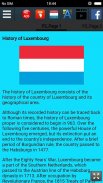










History of Luxembourg

Description of History of Luxembourg
The history of Luxembourg consists of the history of the country of Luxembourg and its geographical area.
Although its recorded history can be traced back to Roman times, the history of Luxembourg proper is considered to begin in 963. Over the following five centuries, the powerful House of Luxembourg emerged, but its extinction put an end to the country's independence. After a brief period of Burgundian rule, the country passed to the Habsburgs in 1477.
After the Eighty Years' War, Luxembourg became a part of the Southern Netherlands, which passed to the Austrian line of the Habsburg dynasty in 1713. After occupation by Revolutionary France, the 1815 Treaty of Paris transformed Luxembourg into a Grand Duchy in personal union with the Netherlands. The treaty also resulted in the second partitioning of Luxembourg, the first being in 1658 and a third in 1839. Although these treaties greatly reduced Luxembourg's territory, the latter established its formal independence, which was confirmed after the Luxembourg Crisis of 1867.
In the following decades, Luxembourg fell further into Germany's sphere of influence, particularly after the creation of a separate ruling house in 1890. It was occupied by Germany from 1914 until 1918 and again from 1940 until 1944. Since the end of the Second World War, Luxembourg has become one of the world's richest countries, buoyed by a booming financial services sector, political stability, and European integration.





















